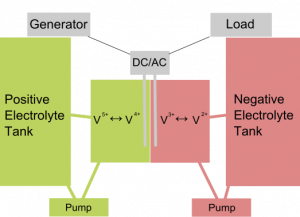Jun
20
Storing The Power Of The Wind
June 20, 2008 | 9 Comments
The wind blows at its own time and not necessarily when people need the power from the turbine. That makes energy storage for wind power production an important field. Wind turbines are going up at incredible rates worldwide and offer another problem besides the storage issue – the intermittentcy in very widely disbursed wind farms can “vibrate” the grids stability. These two problems are racing to answers.
The Electricity Storage Association had its annual meeting recently with manufacturers, utilities and policy people gathered to look at the issues and some of the solutions. The expert presentations looked at how energy storage can work across multiple roles from the frequency vibration issue in real time on to momentary, daily and on to weekly monthly and even seasonal storage. The experts also showed why storage will be valuable for integrating new sources of generation, stabilizing the grid and offering energy autonomy for grid segments and mediating against intermittent power interruptions.
A backdrop to this is the U.S. Energy Storage Systems Act of 2007. While it authorizes money it doesn’t appropriate any, so the law is on the books and if someone in Congress can get an appropriation some basic and applied research money could get released. That prospect has added a little fuel to the fire. But the industry already has some legs.
NGK Insulators of Japan has over 200 megawatts of their NaS batteries installed across the world. Used for mainly for load shifting and leveling, the batteries store from peak production to sell at peak load.
VRB Systems of Canada is using vanadium flow battery technology for frequency regulation, voltage support and blackstart capability. The battery installations in Canada and Alaska smooth the wind turbine output and cut diesel fuel costs particularly for hybrid wind and diesel generating sets. The vanadium flow battery allows generators when running to be set for maximum efficiency.
Storage will change the operating environments for utilities. Southern California Edison is proposing 250 megawatts of photo voltaic that it would own on large unused commercial rooftops. SCE understands that storage can shift the photo voltaic production peak of noon to mid afternoon’s load peak and remove intermittent output and offer emergency backup power. That changes the economics on pricing.
Thermal solar and wind are often now and over time to be located at the edge of grids. Storage offers substantial benefits to managing these fuel cost free sources to match the electrical load economy. As storage is added it would offer better pricing and integration of more renewable resources.
Some of the storage proposals can be sourced close to load, or the source or anywhere on a grid. As sales volume increases, some manufacturing volume and scale should drop prices. No matter the power source, storage will offer protection from mistakes in demand forecasting, removes barriers in connecting new sources, allows connections at different grid voltages, and could be used to avoid some kinds of grid upgrades.
Batteries may be the market today but compressed air, water lifting back behind dams, and other ideas are getting more interest now as wind is adding new power quickly and looks to increase for years to come.
For wind power to expand at great scale the storage options will need to be available which suggests that governments might wish to add practical incentives and fund the research to speed things up.
Comments
9 Comments so far




Brian-
Thanks for raising these important points about the need to develop energy storage systems if we are to transition to a greater reliance on solar, wind, and other renewable energy technologies.
It does us little good for us to push ahead with reckless abandon in support of wind energy (not that we are), without looking at the concomitant issues of electricity storage.
Nice post. Looks like wind power is really starting to get some serious consideration in Australia now.
actually it is not that hard to setup wind farms, the only problem is that it requires lots of capital investment.”*;
wind farms in germany are great! i hope that we could install those in every country:,`
our hometown already have wind farms and it is great to know that we have a reneawable electricity source’:,
Wow this is a great resource.. I’m enjoying it.. good article
How did you research your tour to China?
wind farms.. that is really cool… love the post : )
hi!,I like your writing so a lot! percentage we be in contact extra about your post on AOL? I require an expert in this area to unravel my problem. Maybe that is you! Looking ahead to peer you.